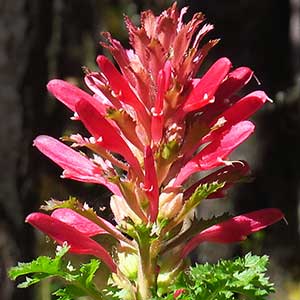Pedicularis densiflora
Pedicularis labradorica
Indian warrior, warrior's plume
Labrador lousewort, pédiculaire du Labrador
basal 1–10, blade lanceolate, 30–200 x 20–70 mm, 2(or 3)-pinnatifid, margins of adjacent lobes nonoverlapping or extensively overlapping distally, 1-serrate, surfaces glabrous, hispid, or downy;
cauline 4–20, blade lanceolate, 15–250 x 5–100 mm, 2-pinnatifid, margins of adjacent lobes nonoverlapping or extensively overlapping distally, serrate, surfaces glabrous, hispid, or downy.
basal 2 or 3, blade lanceolate, 10–20 x 2–3 mm, 1- or 2-pinnatifid, margins of adjacent lobes nonoverlapping, serrate, surfaces glabrous;
cauline 1–4, blade linear to lanceolate, 10–50 x 2–10 mm, undivided or 1- or 2-pinnatifid, margins of adjacent lobes nonoverlapping, serrate to 2-serrate, surfaces glabrous or sparsely downy to hispid.
simple, 1–5, exceeding basal leaves, each 10–50-flowered;
bracts lanceolate to trullate, 10–35 x 3–5 mm, undivided or 1-pinnatifid, proximal margins entire, distal 1- or 2-serrate, surfaces glabrous.
paniculate or buds present in cauline leaf axils, 1–8, exceeding basal leaves, each 5–20-flowered;
bracts linear to narrowly lanceolate, 7–15 x 1–2 mm, undivided or 1-pinnatifid, proximal margins entire, distal 1- or 2-serrate, sometimes crenulate, surfaces glabrous or hispid.
2–4 mm.
0.5–2 mm.
calyx 9–18 mm, downy to tomentose, lobes 5, triangular, 3–4 mm, apex entire, ciliate;
corolla 23–43 mm, tube dark red, purple, or orange-yellow, rarely white, 8–18 mm;
galea dark red, purple, or orange-yellow, rarely white, 15–25 mm, beakless, margins entire medially and distally, apex straight;
abaxial lip dark red, purple, or orange-yellow, rarely white, 8–15 mm.
calyx 5–8 mm, glabrous, lobes 2, triangular, 0.5–1.5 mm, apex entire, sometimes slightly bifurcate, glabrous;
corolla 12–18 mm, tube deep yellow, 7–10 mm;
galea dark yellow or yellow tinged with purple or spotted, 5–9 mm, beakless, margins entire medially, 1-toothed distally, apex arching over abaxial lip;
abaxial lip dark yellow, 5–7 mm.
= 16.
= 16.
Pedicularis densiflora
Pedicularis labradorica
Scarlet corollas with an undomed, toothless galea and two- or three-pinnatifid leaves are diagnostic of Pedicularis densiflora. This species occurs in forested subalpine regions of southern Oregon, western slopes of the Sierra Nevada, and the Coast Ranges of California south to Baja California. Herbarium records indicate northern populations of P. densiflora occur at higher elevations than do more southern populations.
(Discussion copyrighted by Flora of North America; reprinted with permission.)
The flowers of Pedicularis labradorica are usually yellow or dark yellow, and the galea is tinged distally with red or purple; sometimes, the yellow color of the tube abruptly transitions into red or purple. Hultén based var. sulphurea on the solid yellow color variant from the Yukon.
(Discussion copyrighted by Flora of North America; reprinted with permission.)


